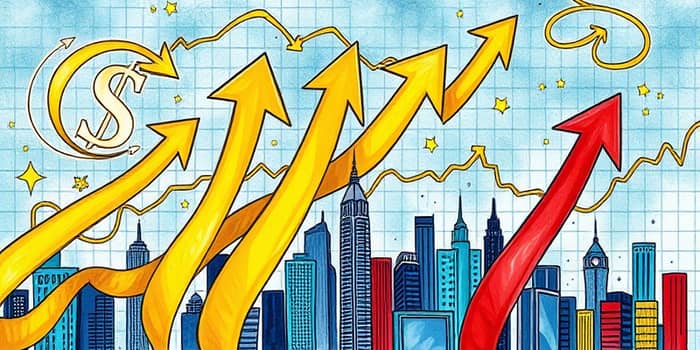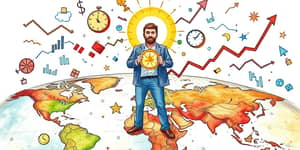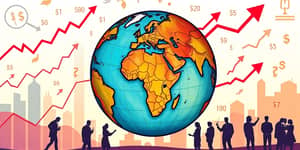The landscape of global finance is shifting under the weight of rising interest rates, influencing everything from consumer choices to national debt levels. In this article, we explore how these changes reverberate through markets and offer practical guidance for navigating uncertain times.
Understanding the Current Rate Environment
As of March 2025, the Federal Reserve has maintained rates after successive hikes, signaling caution amid persistent inflation. Despite forecasts of three rate cuts this year, bringing the federal funds rate down to 3.50%–3.75%, the journey ahead remains delicate.
Projected rate adjustments suggest a shift in monetary policy, but the timeline is uncertain. Morningstar expects further easing in 2026, targeting 2.25%–2.50%. Yet these figures hinge on inflation trends, employment data, and global events.
Economic Growth and Recession Risks
The International Monetary Fund now forecasts U.S. growth at 1.8% for 2025, down from earlier estimates. While not signaling a full-blown recession, this pace reflects a notable slowdown.
A 40% probability of recession has been cited by analysts, up from about 25% six months ago. Still, the economy’s resilience—driven by a robust labor market—provides a cushion against severe downturns.
Effects on Consumers and Businesses
When borrowing costs climb, consumers tighten their budgets. Auto loans, credit cards, and personal lines of credit become more expensive, prompting households to defer big-ticket purchases and prioritize debt repayment.
Businesses face similar pressures. Higher interest rates increase the cost of capital for expansions, research and development, and working capital. Companies often delay new projects or scale back hiring, impacting overall economic momentum.
Housing Market Challenges
Mortgage rates near 6.7% have dampened demand for new homes, slowing a sector that traditionally fuels job creation and consumer spending. Homebuilders report fewer starts and permit applications, while existing-home sales have settled back toward pre-pandemic norms.
Prospective buyers are caught between rising rents and mortgage payments, complicating long-term housing decisions. Policymakers must balance rate policies with incentives to maintain market stability.
Inflation Control and Currency Strength
One of the Fed’s primary goals is to rein in inflation. By making credit more expensive, demand softens, and price pressures ease. Recent data show core inflation at 2.8%, a significant drop from pandemic-era peaks.
Higher rates also boost the dollar’s value by attracting foreign investment seeking superior yields. A stronger currency reduces the cost of imports but can make exports less competitive, posing a dilemma for trade balances.
The Fiscal Impact and National Debt
Rising rates increase interest expenses on government debt. An estimated half-point rate hike could swell the federal deficit by $1 trillion over ten years. This creates tension between short-term monetary goals and long-term fiscal sustainability.
Policymakers face a dual challenge: controlling inflation without exacerbating budget deficits or crowding out private investment through excessive borrowing costs.
Market Reactions and Investor Sentiment
Equity markets often fluctuate in response to rate decisions. Sectors reliant on cheap financing—technology, utilities, and real estate—tend to underperform when rates climb, while financial institutions may benefit from wider interest margins.
- Interest-sensitive stocks may see reduced valuations.
- Bank earnings can improve, driven by higher lending rates.
- Bond yields rise, affecting portfolio allocations.
Practical Strategies for Individuals and Businesses
Navigating a high-rate environment requires foresight, resilience, and disciplined planning. The following approaches can help stakeholders adapt and thrive:
- Build an emergency fund covering 3–6 months of expenses to cushion against job or income volatility.
- Refinance or lock in fixed-rate loans when possible, preserving lower rates for the long term.
- Diversify investments across asset classes—equities, bonds, real estate—to balance growth and stability.
- Monitor debt levels and prioritize high-interest obligations to reduce overall borrowing costs.
Navigating Policy Uncertainty
Closely tracking Federal Reserve communications and economic indicators is essential. Key data points include inflation readings, unemployment rates, and GDP growth updates.
Engage with financial advisors or utilize sophisticated analytic tools to adjust portfolios in response to evolving conditions. In the business realm, scenario planning helps executives anticipate multiple interest-rate paths and their implications.
Looking Ahead with Confidence
While rising interest rates introduce complexity, they also reflect an economy striving for balance between growth and price stability. By understanding the mechanisms at play and adopting proactive measures, individuals, companies, and policymakers can transform challenges into opportunities.
Strategic financial planning, adaptive business models, and informed policymaking will pave the way for sustained prosperity. In this era of heightened vigilance, resilience and insight are the keys to charting a course through turbulent economic waters.
References
- https://www.jpmorgan.com/insights/outlook/economic-outlook/fed-meeting-march-2025
- https://www.morningstar.com/markets/when-will-fed-start-cutting-interest-rates
- https://www.imf.org/en/News/Articles/2025/04/22/tr-04222025-weo-press-briefing
- https://www.frbsf.org/research-and-insights/publications/economic-letter/2025/04/underlying-trends-in-us-neutral-interest-rate
- https://www2.deloitte.com/us/en/insights/economy/us-economic-forecast/united-states-outlook-analysis.html
- https://www.ig.com/en/trading-strategies/what-are-the-effects-of-rising-interest-rates--221223
- https://www.investopedia.com/articles/investing/010616/impact-fed-interest-rate-hike.asp
- https://home.treasury.gov/news/press-releases/sb0114










